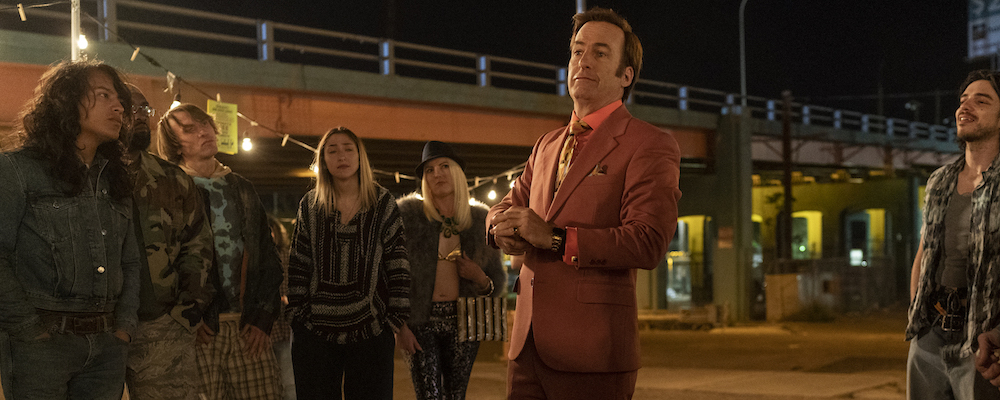‘Better Call Saul’ Season 5 Begins Its Saga’s Dark Endgame
Alci Rengifo
“Better Call Saul” is one great character study. Even as it hurtles closer to the narrative of its predecessor, “Breaking Bad,” it is essentially the portrait of various personalities scheming in a game where the smartest criminal wins. Season five begins with not one but two slow burner episodes where Jimmy McGill a.k.a Saul (Bob Odenkirk) settles into his role as crooked lawyer, dreaming big while the other hustlers in this tale inch closer to a full out drug war.
As always we begin in a black and white future where a post-“Breaking Bad” Jimmy, using the alias Mr. Takovic, is still nervously trying to avoid Jeff (Don Harvey), the cabby who might be on to his real identity as the infamous gangland lawyer from Albuquerque. Jimmy decides to call the Disappearer (the late great Robert Forster) and try to get a new identity. He then rushes to hide away his stash of diamonds. Cut to the color present where Jimmy has managed to get reinstated into the New Mexico State Bar. He’s also changing his name to Saul Goodman while planning a cell phone giveaway complete with a 50% discount for society’s lawbreakers as a get-clients-quick scheme. Partner Kim (Rhea Seehorn) isn’t too excited about any of these ideas, not even when Jimmy takes her on a tour of a potential big house they could buy. Over in the criminal underworld a clash is brewing between Gus Fring (Giancarlo Esposito) and Lalo Salamanca (Tony Dalton). Lalo knows his meth is diluted and it’s connected to the product being provided to him by Fring. Fring explains it was the fault of a German his crew has already taken care of, and is in fact using that German’s leftover crew to continue building a massive freezer. Hovering around is double agent Nacho (Michael Mando), who was forced to work for Fring when the latter discovered his hand in nearly killing Nacho’s own Don.
The style of “Better Call Saul” remains consistent and eschews fast action for patients, almost meditative scenes driven by pure dialogue and tension. Creators Vince Gilligan (creator of “Breaking Bad”) and Peter Gould, have designed this show to be more about what drives shady characters as opposed to just what they do. Jimmy a.k.a. Saul wants a big house, he wants to live large and afford more of his tacky suits. When he takes Kim on a tour of a house he covets she points out the massive closet would be better for him. Later he will push Kim to violate their ethics as lawyers with clients, and she hesitates but soon gives in. But there’s a sense the relationship is getting to the point of no hope. Jimmy as Saul hustles from one client to the next, handing out cards like candy, but there’s little joy if any in Kim’s expression. Fring and Lalo also get long interactions, including a particularly well-written one where the two sit facing each other across a table, where Fring issues a precise apology for what happened with Lalo’s meth. But the tone shows he’s hiding something and Lalo knows it.
At times the two episodes swerve from passivity to near-surrealism, as when Jimmy begins promoting his fifty percent discount to obviously shady customers, handing out phones and promises. Later two drug users will go on a wild binge, crashing their car and carrying out robberies while shrieking “fifty percent off!” Even the scene where Fring shows Lalo the giant freezer being built by Germans in a giant warehouse is a strange sight. The rest of the Germans, who used to follow gangster Werner Ziegler (Rainer Bock) before he was axed by Mike (Jonathan Banks), are sent home. Like “Breaking Bad” the point is criminal enterprises can verge on the strange. Mike also gets an engaging side storyline where he tries to spend some time with his actual family, instead scaring his granddaughter in an unnerving moment where she’s trying to do an outdoor activity and he explodes. It’s a signal of how Mike will soon lose something precious in life and be left with only criminals as his family.
There’s not much that “happens” usually in a slow burner. Action tends to be quick and sporadic, like a moment where one of Lalo’s distribution houses gets raided by the cops (after a hilarious bit involving a clogged pipe) and Nacho runs back in, leaping across rooftops to save their meth stash. Major plot developments care carried out with a fittingly disturbing ease. Jimmy gradually becomes Saul, and in the process becomes the Jimmy we remember from “Breaking Bad.” The final moment of the second episode finds him getting into a car with Nacho, and he’s driven off towards his destiny.
After this season “Better Call Saul” is scheduled for one more round before exiting. While its initial appeal was always as being the prequel to “Breaking Bad,” it has developed its own identity and following by sharply focusing on its characters. There’s little actual violence, notice how these episodes range from 1 hour and 19 minutes to a simple hour yet cruise by with elongated montages and moments of pure dialogue. How Jimmy transforms into Saul and then into the lawyer we grew to like and despise in “Breaking Bad” is the real plot. It’s an evolutionary process we want to follow to the end.
“Better Call Saul” season five premieres Feb. 23 and 24 and airs Mondays at 9 p.m. ET on AMC.

